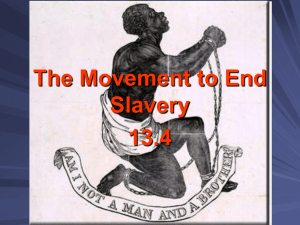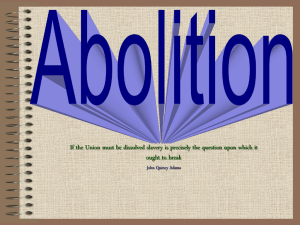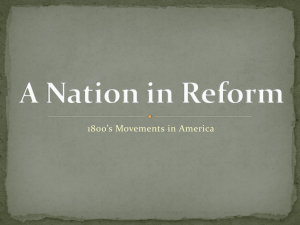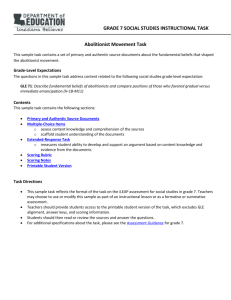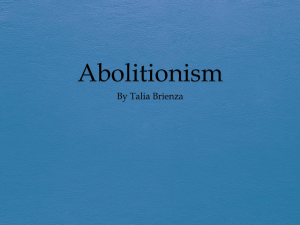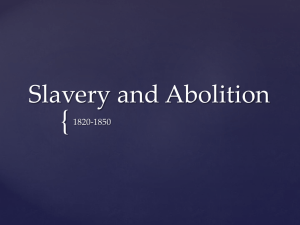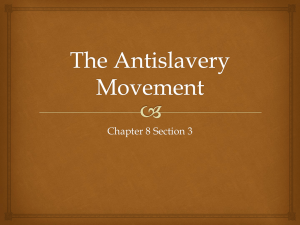8-4.2 Analyze how sectionalism arose from racial
advertisement
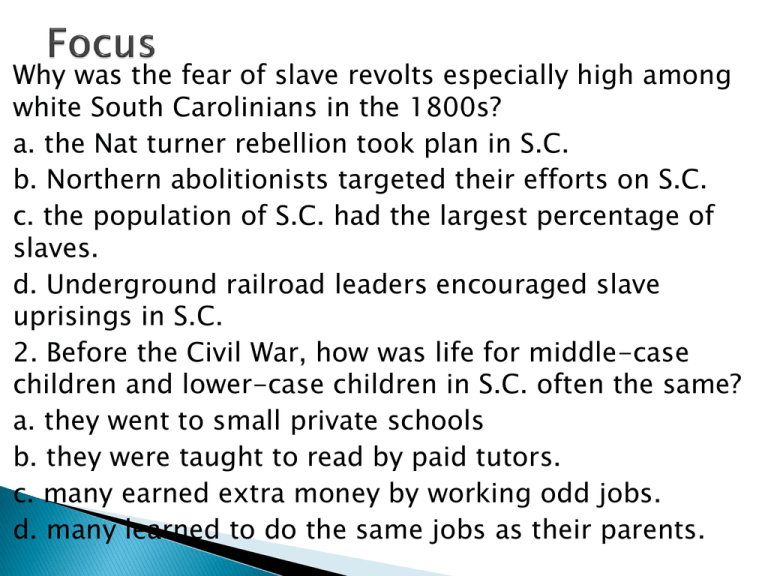
Why was the fear of slave revolts especially high among white South Carolinians in the 1800s? a. the Nat turner rebellion took plan in S.C. b. Northern abolitionists targeted their efforts on S.C. c. the population of S.C. had the largest percentage of slaves. d. Underground railroad leaders encouraged slave uprisings in S.C. 2. Before the Civil War, how was life for middle-case children and lower-case children in S.C. often the same? a. they went to small private schools b. they were taught to read by paid tutors. c. many earned extra money by working odd jobs. d. many learned to do the same jobs as their parents. 1. The cartoon above represents the U.S. in the 1850's. What point is being made? a.The country was being divided by the issue of slavery b.The wealth of the United States was in the South. c.The wealth of the United States was in the north. 2. Like they did in the Stono Rebellion of 1739, plantation owners reacted in which way to the failed Denmark Vesey plot in 1822? a.They replaced many African slaves with Native American slaves b.They passed more laws and restrictions to control slaves. c.They temporarily suspended the practice of owning slaves. 3. Which of the following statements is true of the abolitionist movement? a.Following the uncovering of the Denmark Vesey plot, many southern abolitionist were either forced out of the south or kept silent. b.Abolitionists like Angelina and Sarah Grimke were successful in their efforts to gain South Carolinians support. c. All of Above 1. Most white men in the antebellum South could BEST be described as A)plantation owners. B)seafaring traders. C)merchants or shopkeepers. D)nonslaveholding family farmers. 2. Which abolitionist was known as"Black Moses"? 3. John Brown, The Martyr,, 1870. How is the concept of "sectionalism“ conveyed in this image? A)The image conveys support for Northern abolitionists. B)The image conveys support for southern "State's Rights" factions. C.The image conveys positive opinions about the Fugitive Slave Act. D)The image conveys negative opinions about the Kansas-Nebraska Act. 1. Why did Uncle Tom’s Cabin and the Liberator help the cause of the abolitionists? a. It was written by a northerner. b. It showed the good that abolitionists accomplished. c. It depicted slave owners as cruel and hardhearted. d. It promoted the denunciation of slavery by various religious groups. 2. What was the main argument that Southerners made in defense of slavery? A) If the founding fathers had slaves, it should be OK for people who lived in the 1850s to have slaves. B) It was up to the states to deal with the use of slavery because it was provided for in the Constitution. C)The future of American economic development depended upon the continued existence of the Southern system of slavery. D)The workers in the Northern cities were similar to Southern slaves, so it should be okay for slaves to work on plantations in the South. Loyalty to a particular region or section of a country instead of to the nation as a whole. Sectionalism developed in the period after the ratification of the Constitution, the economies, cultures and political interests of the North and the South became more and more different. Sectional differences first developed in the colonial period as a result of the different geographies of the regions. The North developed as a trading region of small farms and the South developed the plantation system. Although all regions had slavery prior to the American Revolution, after the war was over, Northern states passed laws to gradually emancipate their slaves. In the South, the invention of the cotton gin led the South to become even more economically dependent upon slave labor. Although both Northerners and Southerners supported the ratification of the Constitution, the different interests of the regions helped to create the two-party system. Southerners tended to be DemocraticRepublican followers of Thomas Jefferson who called themselves Republicans. New Englanders tended to be Federalists (Whigs). Jefferson’s Republicans became Jackson’s Democrats. Lincoln Republicans are the ideological descendants of the Federalists. The political parties and the regions increasingly took different positions on the issues of the day. Sectionalism intensified as a result of the growing slave population in the South. In South Carolina, by the 1720s, the black population surpassed the white population and there was an African American majority in most Southern states. Although the International Slave trade was outlawed in 1808, the numbers of slaves grew due to higher birth rates and smuggling. This growing population increased the fear of slave revolts. The Denmark Vesey Plot caused South Carolinians to become even more fearful of their slaves. Slave codes that had been developed as a result of the Stono Rebellion during colonial times were strengthened to better protect white society. http://www.youtube.com/watch?v=4N-BYzJoVJo http://www.youtube.com/watch?v=j05sCUvzKQ0 The General Assembly passed laws the prohibited slaves from meeting, learning to read and write and that regulated all aspects of slaves’ lives. A similar uprising in Virginia, the Nat Turner Rebellion, further increased tension throughout the region. Southerners feared that if slavery could not expand into the territories eventually the national government would be in the hands of the North, slavery would be outlawed and Southerners would have among them a large African American population that they could not control. Tension also arose as a result of the growing abolitionist movement. The goal of the Abolitionist Movement was to outlaw slavery throughout the United States. Although Abolitionism grew in the North, it was effective in S.C. only in making slave owners more determined to hold on to their “peculiar situation”. Abolitionists were active in S.C. prior to the uncovering of the Denmark Vesey Plot. However, after the plot was uncovered, abolitionists such as Sarah and Angelina Grimke were forced to either leave the state or keep silent. The Abolitionist Movement was not popular among most northerners. The Abolitionist Movement grew with the publication of the antislavery newspapers such as The Liberator by William A Garrison. Postmasters across S.C. removed from the mails what they considered inflammatory materials including anti-slavery newspapers. However, they could not keep abolitionists from reaching a larger and larger Northern audience. Southerners responded to abolitionists’ criticism by claiming that slavery was a ‘positive good’, because slaves were cared for throughout their lives, unlike northern laborers that they termed ‘wage slaves’ Abolitionists manned the Underground Railroad with limited impact in South Carolina since the state was too far from the border with “free states” to make this escape route effective. Abolitionists played a role in all of the incidents that furthered tension between the North and the South.. Sectionalism was furthered also by changes in the Northern economy and politics. The development of industry in the North attracted European immigrants to jobs there. The resulting growth of population allowed the Northern states to have a larger representation in the House of Representatives. Another political party that supported a strong national government, called the Whigs, emerged to compete with Democrats, many of whom were southerners, for control of the presidency and Congress. Concern over the North’s greater voice in Congress led the South to compete rigorously for the admission of new states as slave states in order to maintain the balance of slave and free states in the Senate.

